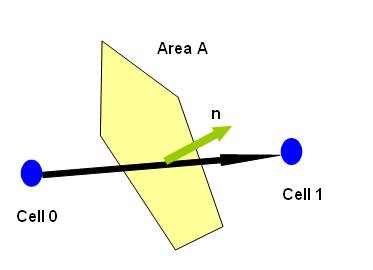Diffusion term
From CFD-Wiki
m |
|||
| Line 43: | Line 43: | ||
== Reference == | == Reference == | ||
| - | # | + | #{{reference-book|author=Ferziger, J.H. and Peric, M.|year=2001|title=Computational Methods for Fluid Dynamics|rest=ISBN 3540420746, 3rd Rev. Ed., Springer-Verlag, Berlin.}} |
| - | # | + | #{{reference-paper|author=[http://www.h.jasak.dial.pipex.com/ Hrvoje, Jasak]|year=1996|title=Error Analysis and Estimation for the Finite Volume Method with Applications to Fluid Flows|rest=PhD Thesis, Imperial College, University of London ([http://www.h.jasak.dsl.pipex.com/HrvojeJasakPhD.pdf download])}} |
Revision as of 09:42, 15 September 2005
Contents |
Discretisation of Diffusive Term
Description
Note: The approaches those are discussed here are applicable to non-orthoganal meshes as well as orthogonal meshes.
A control volume in mesh is made up of set of faces enclosing it. The figure 1.1 shows a typical situation. Where A represent the magnitude of area of the face. And n represents the normal unit vector of the face under consideration.

Figure 1.1
 and
and  are position vector of centroids of cells cell 0 and cell 1 respectively.
are position vector of centroids of cells cell 0 and cell 1 respectively.

We wish to approaximate  at the face.
at the face.
Approach 1
Another approach is to use a simple expression for estimating the gradient of scalar normal to the face.
where  is suitable face averages.
is suitable face averages.
This approach is not very good when the non-orthogonality of the faces increases. Instead for the fairly non-orthogonal meshes, it is advisable to use the following approaches.
Approach 2
We define vector

giving us the expression:
where  and
and  are suitable face averages.
are suitable face averages.
Reference
- Ferziger, J.H. and Peric, M. (2001), Computational Methods for Fluid Dynamics, ISBN 3540420746, 3rd Rev. Ed., Springer-Verlag, Berlin..
- Hrvoje, Jasak (1996), "Error Analysis and Estimation for the Finite Volume Method with Applications to Fluid Flows", PhD Thesis, Imperial College, University of London (download).

![D_f = \Gamma _f \nabla \phi _f \bullet \vec A = \Gamma _f \left[ {\left( {\phi _1 - \phi _0 } \right)\left| {{{\vec A} \over {d\vec s}}} \right|} \right]](/W/images/math/e/b/a/eba7a8f962a26ccc4322e8e4cde187ee.png)
![D_f = \Gamma _f \nabla \phi _f \bullet {\rm{\vec A = }}\Gamma _{\rm{f}} \left[ {\left( {\phi _1 - \phi _0 } \right)\vec \alpha \bullet {\rm{\vec A + }}\bar \nabla \phi \bullet {\rm{\vec A - }}\left( {\bar \nabla \phi \bullet {\rm{d\vec s}}} \right)\vec \alpha \bullet {\rm{\vec A}}} \right]](/W/images/math/7/7/2/772b96059e9032fc07b25c0dee76db6c.png)